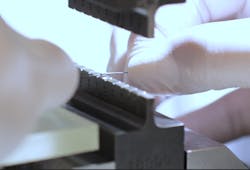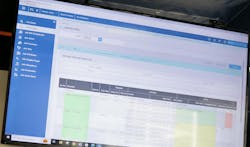Only clean and organized data yields useful analytics for manufacturers. So, imagine yourself as a one-man show at a high mix/low-yield job shop serving highly regulated industries, trying to clean data from eight different systems quickly enough to serve any constructive purpose.
Wes Prunckle, president and CEO of Strand Products, a 55-employee contract manufacturer of mechanical wire, cord and cable assemblies based at a single plant in Ventura, California, didn’t have to imagine. He lived the nightmare.
Strand Products formed in 1991 when parent company Helistrand split into separate mechanical and electronics companies. In 1997, Strand Products became 100% employee owned.
Prunckle began his career at the company in 2004 as a mechanical engineer. Now, in leadership, he focuses on maintaining transparency about operational and financial performance, communicating strategic goals and promoting a culture around team learning, discipline and integrity. Data analysis provides a backbone for these responsibilities.
As a long-serving employee himself, Prunckle remains keenly aware of how his actions dictate the fortunes of his colleagues. That’s what motivated him to accept the preposterously onerous task of correlating data generated by eight separate software packages for accounting, ledger maintenance, quality, inventory and revision control among others, with ERP data to boot.
“Our employees are owners, and they’re vested in the performance of our company. So, they really they deserve to know, they want to know, how their efforts here are impacting the success of our company and our customers and the end users,” Prunckle says.
Cogent, top-level analysis, even something as simple as knowing whether the company made money, became possible only after monthly or quarterly books closed and Prunckle had locked data.
Manually correlating data became more untenable the larger Strand Products became. The company grew from its roots in automotive supply to also serve aerospace, military and medical device manufacturers. Some of Strand’s highly regulated products require ISO certifications and ITAR regulatory compliance, increasing the need for complex data tracking and decreasing tolerance for error.
Lack of real-time data from the manufacturing floor became particularly egregious for a job shop that regularly shifts job priorities or sprints in the face of a constant flow of new orders.
Prunckle began to grasp the scope of the problem when team members throughout the organization, in every department, realized the growth of the company was bound by the capabilities of its ERP system, particularly its weakness handling revision control, job control, engineering changes and something as simple as downtime management.
By 2019, Strand Products had grown so large that along with all the other challenges presented by the insufficient ERP system, Prunckle could not guarantee his ability to collate data fast enough to tabulate results and reward employee performance in a timely manner, owing to the inadequacies of the software. His need to keep colleagues dear to heart could no longer tolerate the situation.
“It couldn’t just be one person creating the plan, one person building the metrics…establishing what the KPIs are, calculating the scorecard for all the managers, with these metrics all tied to our business plan. If everybody meets their metrics, they meet their bonus, and we meet our plan. I saw that how helpful that was and beneficial,” Prunckle says.
“But I also thought, I can’t do this. This is something that I’ve got to be able to set the framework [for] but hold other people accountable for communicating to each other, to managing their goals and speaking up if they need help or resources…I wanted to make that much more seamless and easier for our team,” he adds.
System Deployment is a Team Sport
Even with all the shortcomings of Strand Products’ legacy ERP system, some employees used to the software actually liked it. Prunckle headed off resistance to adopting new software by including all interested parties in the assessment process.
Any decision-maker at the company with accountability for getting their team involved in the integration process knew the available software options and the costs of initial installation, additional licenses and new modules. The entire team drew up documents to specify what software vendors needed to address before Strand could decide which system to deploy. The company chose to deploy the Plex smart manufacturing system developed by Rockwell Automation.
The first hurdle to successfully deploying the new software had nothing to do with people. Strand Products didn’t have the data it needed to make proper use of the system.
Generating real-time, useful production analyses requires accounting for each operational step. Setting an overarching cycle time and monitoring whether production meets overall goals lends no insight into lagging production. The old ERP system from which Strand pulled data to populate the new software didn’t include timers for individual operations.
“There was a lot of benefit in that hurdle. … It forced us to really zoom in on all our operational steps. The way they were written in the past was wrong. It wasn’t how folks were doing them on the floor. So, it’s allowed us to improve our compliance and align how we are really doing things and make sure the system reflects that.” He adds the data collection improvements allows the company to “iterate and improve it together with the engineering team, the quality team, the manufacturing team. All that wouldn’t [have happened] if we didn’t go through this journey. So, it was a challenge, but in the end, it was a big win for us.”
Integrator Cumulus Consulting assigned advisory subject matter experts to Strand’s supply chain, operations, engineering and accounting and finance teams among others, to make sure the correct data pulled from legacy systems and integrated into the new smart manufacturing system.
When it came to reviewing parts data accrued in the ERP system since 2004, as tired as he was of swimming in software, Prunckle knew best how to decide what information needed to migrate to the new smart manufacturing system and which data could remain on the legacy system. He accepted the task as his last hurrah.
Just a Little Automation Can Move the Bottom Line
Many operational aspects of Strand’s business – quality procedures and management such as document control, SOPs, preventative maintenance, machine calibration – still require full integration with the new smart manufacturing system. Older machines lack native data capture functionality and require IoT devices to hook them directly into the system.
Even burgeoning steps into smart manufacturing provided immediate, appreciable results.
Currently, owing to the lack of IoT device integration, operators record production at networked kiosks mounted on casters and spread throughout the facility. The shop has enough WiFi coverage to allow operators to adjust the placement as needed and make sure no operator stands more than a few steps away from a kiosk.
Floor supervisors and managers now can focus on leading and training, not jobs recording. They use the kiosks to look up Gantt charts for specific jobs and analyze downtime patterns to identify whether operators require additional training or reassignment to better use their strengths.
In the plant’s clean room, wall-mounted boards display high-level job tracking screens that show all current jobs and their due dates, with color-coding to illustrate efficiency and remaining time for job completion. Similar boards hang on the main shop floor.
Strand’s top customers can access manufacturing data to track job progress, cutting down on recurring phone calls to update clients with their order status.
Revenues grew 40% to an all-time high during the first year Strand Products deployed the smart manufacturing system. The ability to easily track orders by product or customer sustained on-time delivery rates above 90%. Hooking supply chain data into the system allows Strand to iterate on quoting, and gross margin is up 7% year-to-date.
Machines Crunch Data, Humans Leverage It.
Now, instead of spending huge chunks of his day-to-day working with data, Prunckle focuses on what CEOs and presidents are actually meant to do.
“This is the first year in a long time when I’ve been able to spend a lot of time on writing a strategic business plan and being really thoughtful about it, not just going through the exercise, but being able to iterate. And, that used to be something that I would have to do in the middle of the night and on weekends,” says Prunckle.
“[We can] integrate the management team into this, have bi-weekly strategy meetings, there’s a lot more high-level thinking and zooming out that we’re able to do because the data is there. Plex gives us those tools, that we didn’t have before.”
About the Author
Dennis Scimeca
Dennis Scimeca is a veteran technology journalist with particular experience in vision system technology, machine learning/artificial intelligence, and augmented/mixed/virtual reality (XR), with bylines in consumer, developer, and B2B outlets.
At IndustryWeek, he covers the competitive advantages gained by manufacturers that deploy proven technologies. If you would like to share your story with IndustryWeek, please contact Dennis at [email protected].




